Learn what it looks like for your child to be in sensory dysregulation and how to help them get out of it and prevent it in the future.
Most days at school Zoey* was a handful. Her fiery red hair would blur as she quickly ran around the room, touching everything, climbing, and often squealing. Sometimes, she’d throw things or knock a desk over.
It was a serious situation, and as adorable as this child was, the adults in her life were often walking on eggshells waiting for her to get out of control again.
Teachers were constantly on guard, ready to put her behavioral plan in effect if she became aggressive, which she often did as soon as someone tried to redirect her to story time or learning of any kind. When Zoey showed up on my caseload, I was well aware of her reputation.
And, as her occupational therapist at school, I had fine motor goals we needed to work on, but once I spent some time alone with her, it became evident that at least part of her behaviors were because she was in a state of sensory dysregulation. *Name changed to protect privacy
What is Sensory Dysregulation?
While Zoey’s story is rather extreme, and, in truth, Zoey had a diagnosis of Autism and history of drug exposure in utero – both are known to cause complex sensory issues– many children without any diagnoses experience sensory dysregulation.
Heck, we can as adults too!
So, what is sensory dysregulation exactly? Sensory dysregulation is when the brain is in a state of disorganization because it has been overloaded with too many sensations, not received enough sensations, or has failed to register sensations. 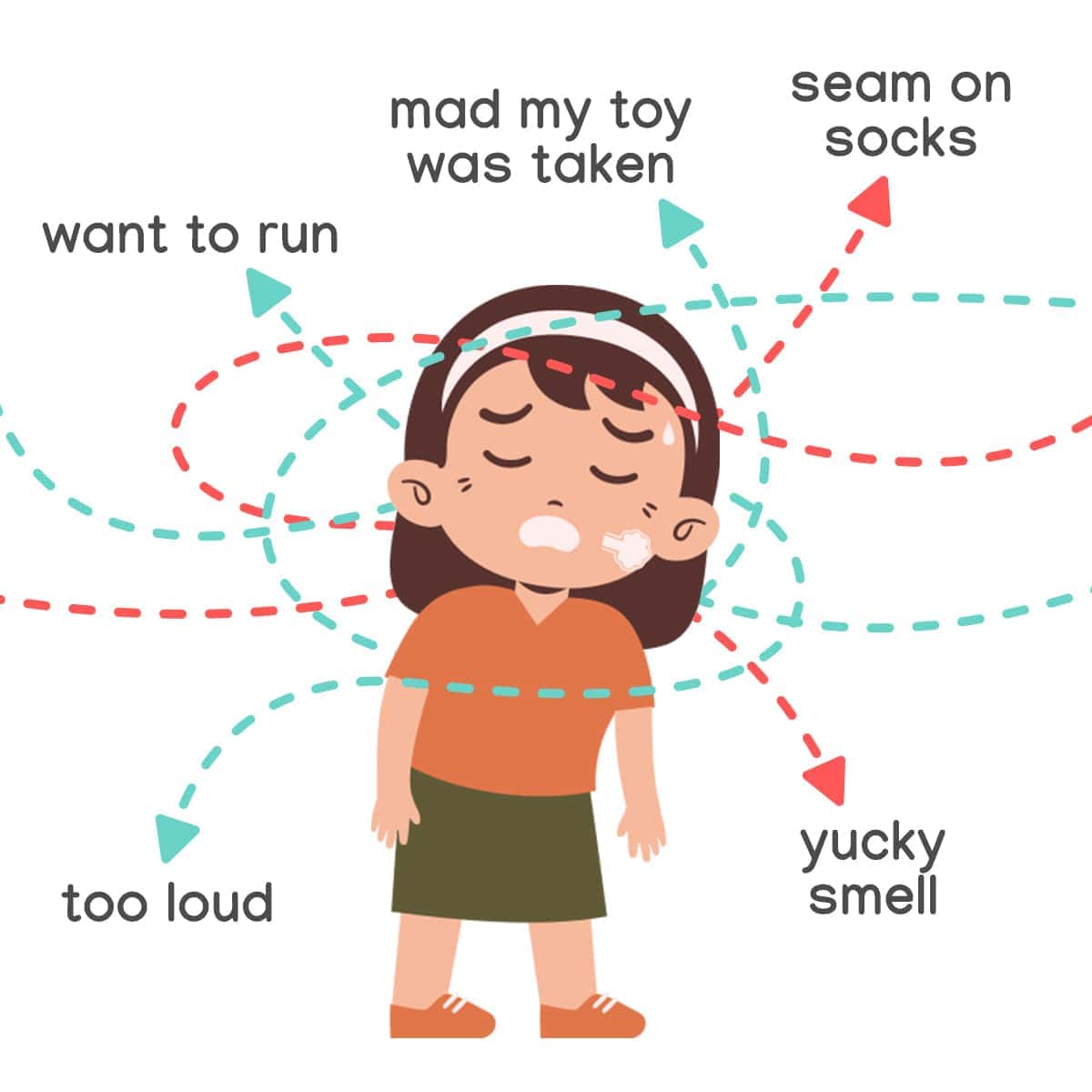
Why do some Kids Become Dysregulated?
The sensory processing aspect of the brain is responsible for sorting through and deciding which sensations to respond to.
In some kids the wiring in this part of the brain may not work efficiently. If that’s the case they will likely be more sensitive too, seek out, or straight up not register sensations.
Unfortunately, as this repeatedly happens in the brain it causes kids to become dysregulated because their brain is so focused on seeking or avoiding certain sensory experiences.
When dysregulation begins and is left unchecked it will get bigger. And the bigger it gets, the more difficult it is for a child to get regulated. Then powerful neurotransmitters flood their brain that cause them to be on guard, nervous, hyper.
It turns into a fight or flight situation, and at that point a sensory meltdown, where the brain basically shuts down, is looming. It can take hours for a child to recover from a meltdown, as well as the parents. Look at this graphic of how dysregulation can build over time: 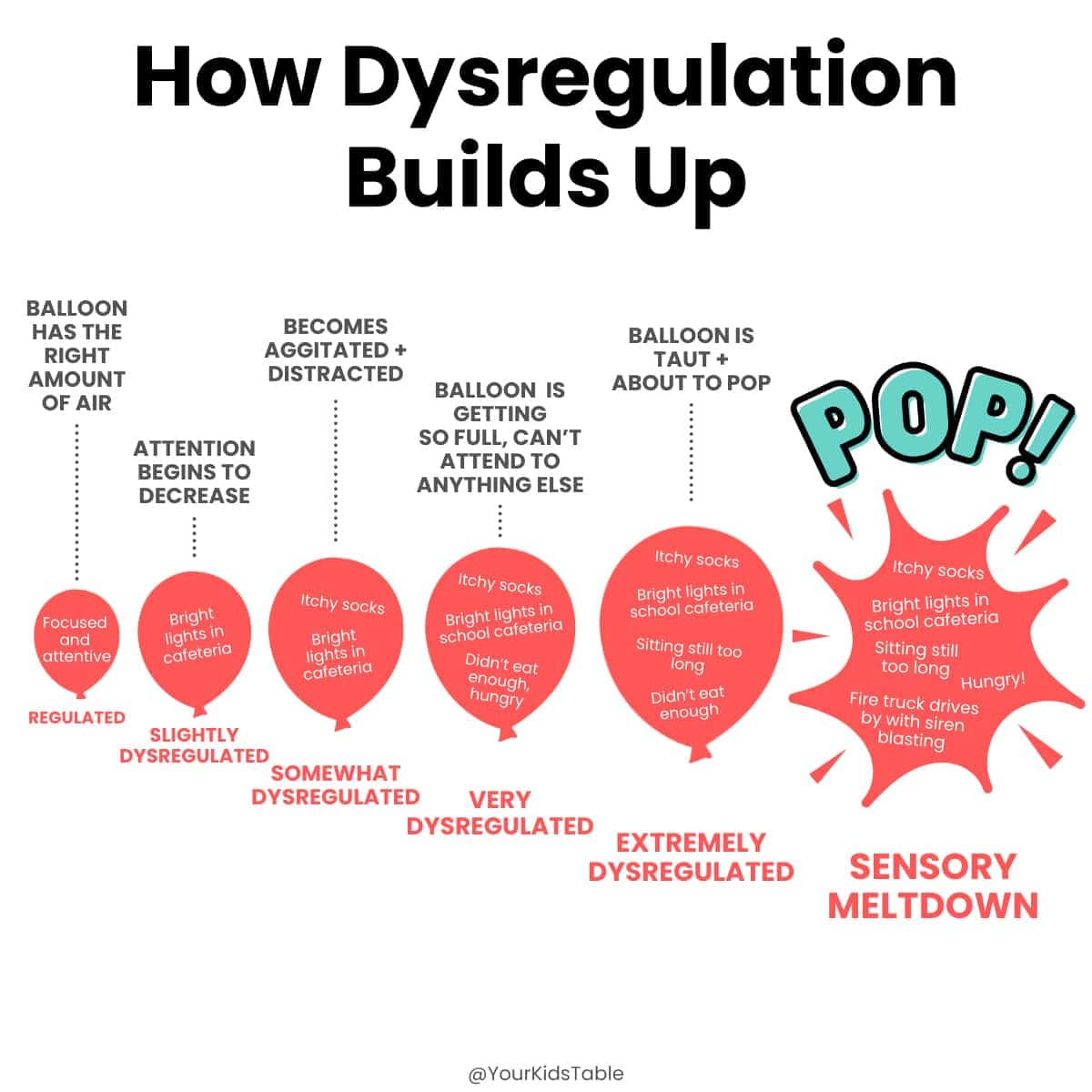
What Does Sensory Dysregulation Feel Like?
Let me give you an example of how you might be triggered into sensory dysregulation.
Imagine putting your hand into something you can’t stand the feeling of. Maybe it’s pumpkin guts or maybe it’s a bucket full of slugs (I’m gagging just thinking about it).
That might sound like a severe example, but that’s exactly my point. If your brain processes sensory stimuli well, then you might have to get extreme to relate to a child that experiences sensory dysregulation on a regular basis.
That’s because your threshold is much higher.
Kids with sensory processing difficulties have a much lower threshold and become dysregulated much more easily.
But, back to the slugs, you’ve put your hand into something you can’t stand the feeling of. The feeling of those slugs would make my hair stand on end. I’d scream. I’d run around shaking my hand. I’d wash my hand vigorously, rubbing very hard. And, if somebody dared try to talk to me, I’d either ignore them because I couldn’t muster a response or I’d snap a nasty response at them because I’d feel out of control and upset.
For a brief time, I’d experience sensory dysregulation. The same would be true if you or I was asked to sit still and not move for a very long time. I can feel dysregulated after I’ve sat at my desk and stared at a computer all day because I wasn’t getting stimulation to my other senses (particularly vestibular and proprioception).
Again, this may happen in a much smaller increment of time for sensory kids. How long varies from child to child. It could be 30 minutes, an hour, or longer.
But the result is the same. Adults and kids alike may feel jittery, angry, and scattered as a result.
Possible Dysregulation Triggers for Kids and Toddlers
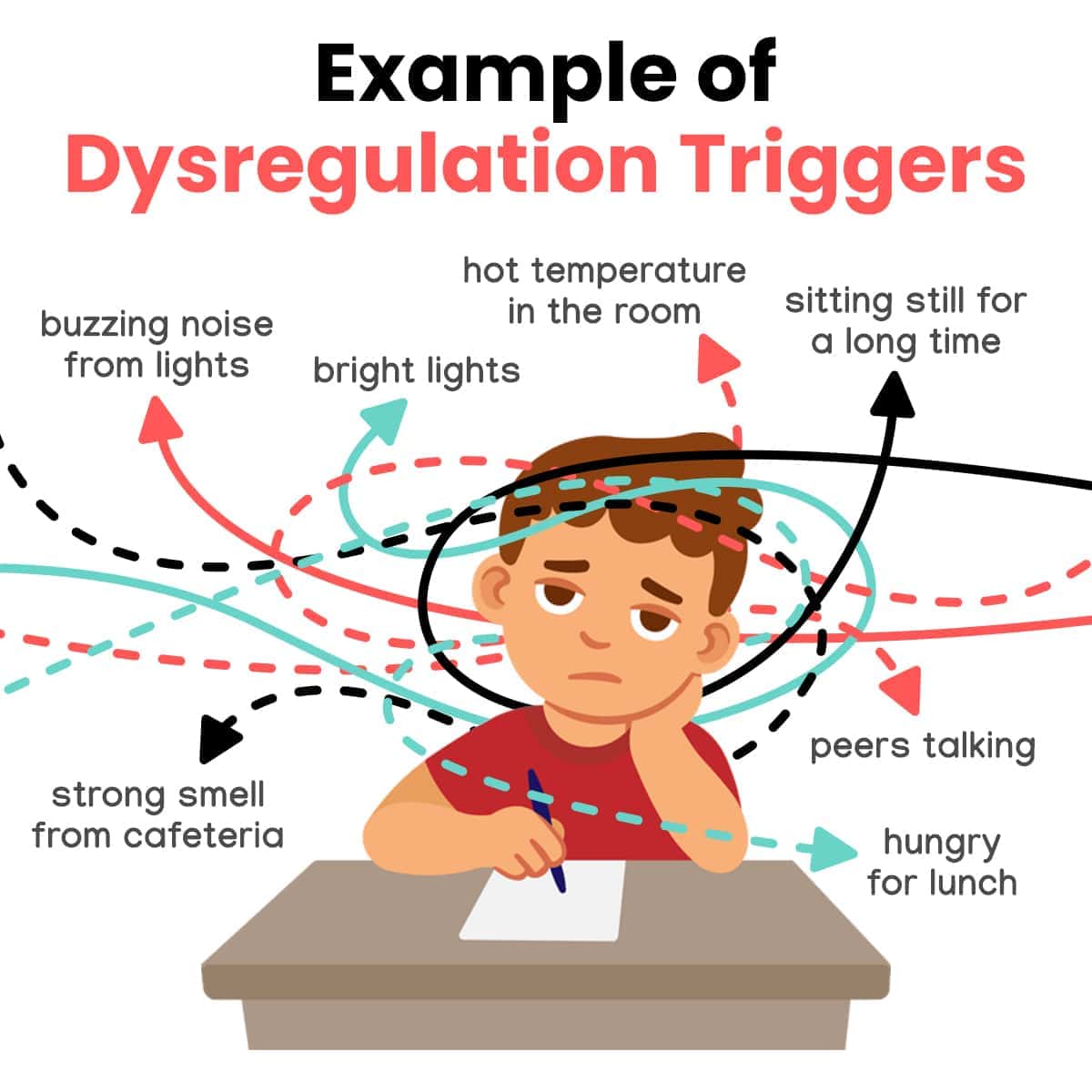 While I’ve given a few examples of what can lead to sensory dysregulation I want to give you a list of potential dysregulation triggers. If you can identify what’s dysregulating your child you can help prevent it from or help get them into a regulated state so they can be responsive and focused on the task at hand.
While I’ve given a few examples of what can lead to sensory dysregulation I want to give you a list of potential dysregulation triggers. If you can identify what’s dysregulating your child you can help prevent it from or help get them into a regulated state so they can be responsive and focused on the task at hand.
Here are some common dysregulation triggers:
- It’s too loud (people talking, television, music, etc.)
- There’s a strong smell in the room
- The lights are bright
- Low frequency background noise that others tend to not notice (lights buzzing, fan clicking, radiator noises, etc.)
- They need to move, jump, or run and can’t (commutes or road trips in a car, learning for long periods at a desk, etc.)
- The food they tried had an overwhelming texture
- There’s a tag in the back of their shirt or seem in their sock they can feel constantly.
- They were forced to finger paint and didn’t like the way it felt
- They aren’t allowed to touch anything and desperately need to
- The clothes they are wearing feel constricting or feel scratchy
- Bathing, washing hair, clipping fingernails, and/or brushing hair felt painful
And, this list could go on and on, for all sorts of sensations. Oftentimes, many of these sensations are bombarding a child at one time and causing dysregulation.
Other Factors that Can Affect Dysregulation
Besides sensations (like lights, sounds, and itchy clothes) there are other factors that can play a role in dysregulating a child more quickly:
- Not enough sleep, being tired
- Needing to eat or drink
- Emotional regulation (feeling very angry, nervous, sad, etc.)
- Feeling very hot or very cold
- Chronic pain or an injury
When the brain has to give more of its attention to any of the above, it has less capacity to manage all the sensations coming in, and meltdowns will often happen more easily.
Signs of Sensory Dysregulation in a Child?
This is why it’s incredibly easy to miss sensory dysregulation! Your child isn’t putting their hand into a bucket of slugs or pumpkin guts, heck you don’t even know what happened.
All you know is that your child is crying, wound up like crazy, or is ignoring everything you say. My son Isaac can become dysregulated when he doesn’t get enough movement, and he needs a lot, more than the average kid.
Like most sensory seekers, he will take his sensory needs into his own hands. That involves semi-dangerous behavior: too roughly wrestling his brothers, climbing furniture, or crashing into things that aren’t meant to be crashed into. When I speak or even yell at him, it’s as if he doesn’t hear me. His mind is so darn focused on getting his sensory system back into balance that his brain isn’t able to process what I am saying to him.
Sensory dysregulation can look like being “bad”, it’s the simplest conclusion that many adults make. In part, that’s exactly what happened to Zoey, and it’s certainly happened to Isaac too. She was difficult to say the least, but her behaviors were also misunderstood. So let’s take a look at what some of the common signs of sensory dysregulation are:
- Crying, terror, overwhelm
- Hiding or retreating to a quiet spot
- Meltdowns
- Extremely wild and dangerous behavior
- Ignoring, refusing, or unable to talk/respond
- Running or moving non stop
- Unable to sit still for an activity or meal
- Angry or emotionally reactive
- Zoned out, lacking energy or desire to do anything
- Wild laughing for seemingly no reason
What Not to Do With a Dysregulated Child

When a child is dysregulated, their behavior can be frustrating.
If we aren’t noticing the signs of dysregulation it can be easy to yell at or punish in our own frustration, but this will only overwhelm their system more, pushing them into deeper dysregulation.
The result will likely be total sensory overload, which we obviously want to avoid. When you notice your child is dysregulated it’s generally helpful to avoid:
- Raising your voice or talking in a frustrated/angry tone
- Giving multiple step directions (because they are hard to process)
- Lightly or unexpectedly touching your child
- Forcing them to use a piece of sensory equipment like a swing or weighted blanket (even if they like this input at other times)
While that may seem like a lot to avoid, there’s a lot you can do, to help your child with dysregulation, which I’ll talk about in the next session. But, know when you begin to understand your child has sensory needs that can be addressed, it changes everything.
I have a free online workshop you can take that teaches you how to do that, check it out here.
How to Help Your Child with Sensory Dysregulation
Once you’ve identified that your child is minimally or moderately experiencing sensory dysregulation, then the next step is see how you can support them.
In your own home it’s usually possible to dim the lights, turn off the tv, or change their clothes if they’re being overloaded with sensations.
But, in school or in public settings you can also provide supports like sunglasses, noise canceling headphones, or fidget toys to squeeze to help them regulate by minimizing overpowering sensations. If they seem to need movement you can provide it!
Sometimes that’s as simple as a walk. Other times an obstacle course, or heavy work activities around the house or classroom can help regulate.
Many kids will self regulate by giving themselves the sensory input they need. Sometimes adults see this as problematic behavior but when a child is chewing on a pencil top it may be helping them stay regulated. Of course they can be given other items to chew on as well. But, oftentimes kids are trying to regulate themselves with the activities they are initiating and that gives us a huge clue into what they need.
Basically anytime you or your child use a sensory activity to help their system regulate you’re using a powerful strategy called a sensory diet. However, if your child is in full sensory dysregulation, you’re likely past the point of helping them with an activity.
Some kids prefer to be totally left alone when they are very dysregulated. They need to decompress in a quiet space. Sensory tents can provide that space and are helpful for some kids.
Other kids may start to regulate with the help of a big deep hug (proprioception) or gentle rocking (vestibular). Proceed with caution if your child is in a meltdown and you attempt a hug or rocking.
Constantly be checking their reaction to see if it’s helping or making the dysregulation worse. What will help a child regulate will vary from child to child and can even change from day to day with the same child.
This is why the right activities for YOUR child are important. You’ll know you’re using the right activity if your child begins to regulate, which is often indicated by them calming down and focusing.
But, the most important thing is that your child learns that you’re there for them, and as you begin to figure out their sensory triggers and needs, you’ll be able to support them better. Once they’ve calmed down or come back into balance, then it’s a good time to talk about how they were feeling. Can they identify what bothered them or what they needed? Depending on their age, they may be able to. Either together or on your own, make a small list of ideas that could help prevent the sensory dysregulation the next time.
And, if you need some ideas, I’ve got a ton of them over in Sensory Diet Activities.
What About Other Sensory Red Flags?
Our kids drop us clues all the time about what’s going on with their sensory processing, but if we don’t know what to look for, we could be missing it!
Download my free 21 sensory red flags below and I’ll send it right to your inbox.
Click here to get the Sensory Red Flags Printable
Remember Zoey? She was dropping me all sorts of clues, like her running around and hitting told me she was probably seeking vestibular and proprioceptive input, when I gave that to her at the start of our session in a swing she was like a different child.
Her attention improved, she made meaningful eye contact and smiled at me often. She was able to transition to working on her fine motor skills.
If you think your child could benefit from more intervention regarding their sensory processing difficulties, consult their pediatrician and they can be evaluated by an occupational therapist that specializes in sensory processing. If OT isn’t an option for you, we do have a full online class, RISE with Sensory, to teach you how to help your child with their sensory issues in your own home.
More on Sensory Dysregulation in Kids
How to Handle a Hyperactive Child without Losing Your Mind
What is Sensory Integration Therapy, Does Your Child Need It?
10 Sensory Red Flags You Might Be Missing
37 Sensory Toys to Help Kids Learn, Communicate, and Calm Down
Alisha Grogan is a licensed occupational therapist and founder of Your Kid’s Table. She has over 19 years experience with expertise in sensory processing and feeding development in babies, toddlers, and children. Alisha also has 3 boys of her own at home. Learn more about her here.
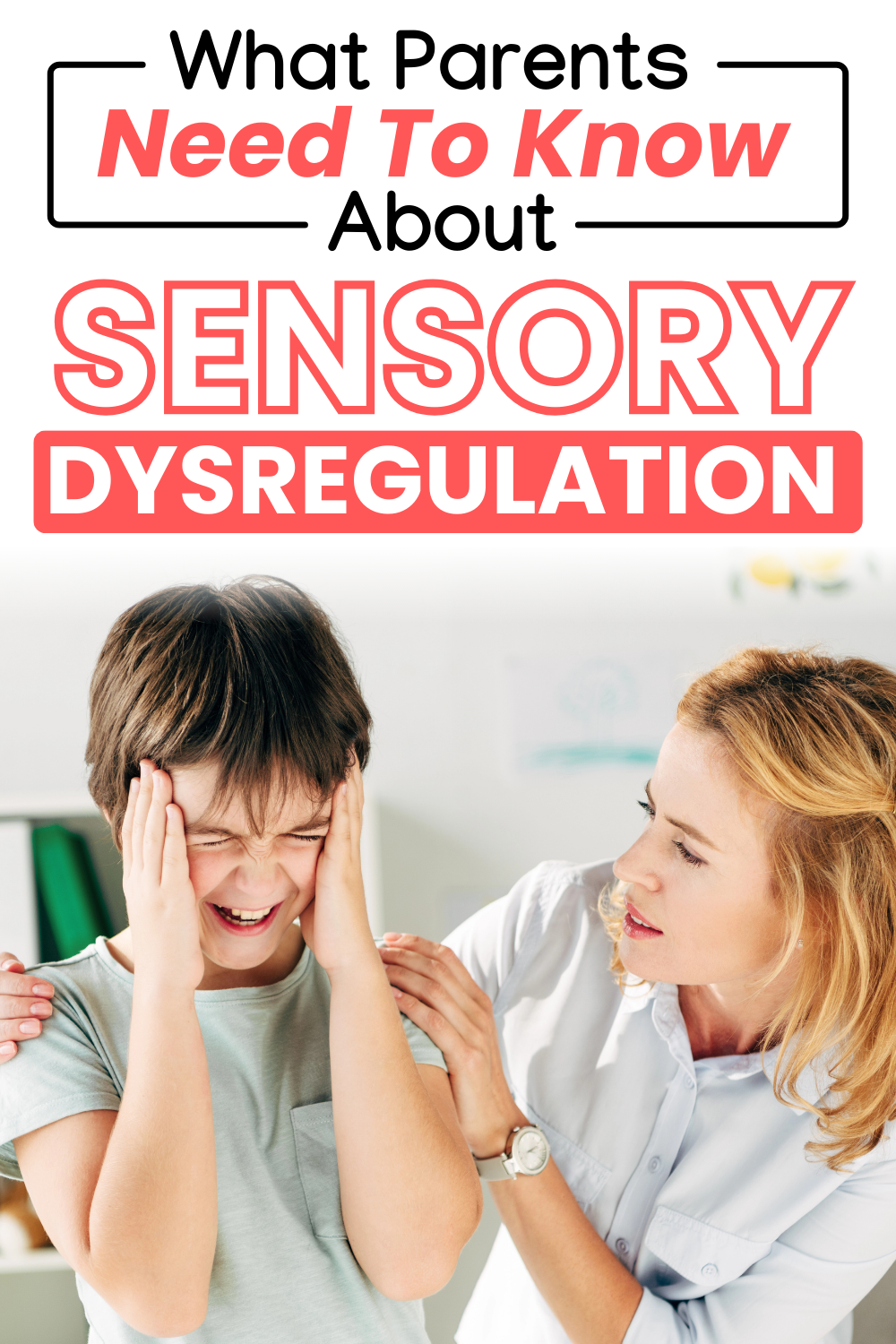
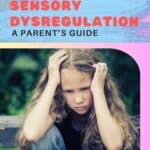
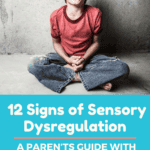
This post was incredibly informative! I had no idea how much sensory dysregulation could impact everyday life for children. Thank you for sharing practical strategies to support kids in managing their sensory needs. It’s definitely something I want to learn more about for my own child!
As a parent of a child with sensory processing issues, this blog post has been incredibly informative and reassuring. It’s great to see the topic of sensory dysregulation being discussed in a way that is easy to understand and accessible to parents. I appreciate the practical tips and strategies provided, and I’m looking forward to trying them out with my own child. Thank you for sharing your expertise and experience!
Thank you for this feedback! Our goal is to be supportive and a positive voice with all things sensory and we are happy to hear this response. Thank you for being a part of this community!
Best,
Laura
Your Kid’s Table team member
I love this information, my granddaughter has been having extremely aggressive wild outburst, not tantrums, she is so unaware and robotic when these occur. I believe we have found the root cause and can now begin to support her.
BTW my maiden name is MAU. My grandparents are from Ill.
Your granddaughter is so lucky to have you advocating for her! Please keep us posted on how things are going and any questions you might have along the way. We have a ton more resources, trainings, and even a monthly supportive membership I can direct you to. And that is so cool you are a Mau! I don’t meet a lot of us around! It is my married name, originally from the northern tip of Germany 😀
Looking forward to hearing how things are going Sandie!
Laura
Your Kid’s Table team member
I really appreciate the information in this blog post. It is so important for parents to be aware of sensory dysregulation and the ways to help their children.
Assuming that sensory dysregulation is much more common in those who are neurodivergent, is it common in neurotypical adults or do neurotypical children tend to grow out of it? Comparatively, how much more common is it in neurodivergent people?
Hi Jordan,
Most people neurotypical and neurodivergent experience sensory dysregulation or preference at some point. You can think of things like an itchy wool sweater that you don’t like to wear or feeling flustered when the noise level in your house gets too high. Those who are neurodivergent may get to that point of dysregulation a little more easily. But each person is individual. I hope that makes sense!
Best,
Andrea
Wow- I’ve been listening to you diet talk and now reading more about sensory dysregulation. Next I will get the list of red flags which I am starting to catch. In just after a few days I’m more aware.
Then activities…
I’m trying to be more supportive as apose to leaving my 8yr old on his own to figure it out.
It’s been almost 5 very difficult years of knowing there were challenges but not knowing what exactly. And sometimes he’s fine and then there’s always the downward spiral to a complete disaster at home for everyone.
He has struggled in school since grade.K. I almost had him assessed when he was 4 for adhd, which I believe he also struggles with. But a Family friend (OCT ) checked him out in our home and said “he’s fine, He’s not on autistic spectrum”…
Anyways, I am so grateful I came across your site! With everything else that’s going on in this world it is so hopeful to know that with my son at home for months due to COVID19 I can try and get this right.
Our whole family will be able to live and love a little bit better.
Thank you,
Shiray Raines
Yes Shiray,
I love your attitude on this time at home with your kids! Keep on reading and learning and let us know if you have any questions along the way! So glad you are enjoying our information. If you haven’t checked out our free sensory workshop, you can save your seat HERE
Best,
Desiree
I really appreciate all of your info, it is VERY hard to find any unless you are a therapist. I have a 9yr with Down Syndrome that still does not chew food, he has oral sensory issues. Could he still learn to chew & what exercises, etc should we be doing? Our insurance doesn’t cover feeding therapy & the school OT/ST would not work on it. Please help!
Hi Stacy,
Thank you for being here. Absolutely you can improve chewing and oral motor skills. Consistency and not pressuring will help. Try these oral motor exercises and let us know how they go.
Best,
Laura
Your Kid’s Table team member